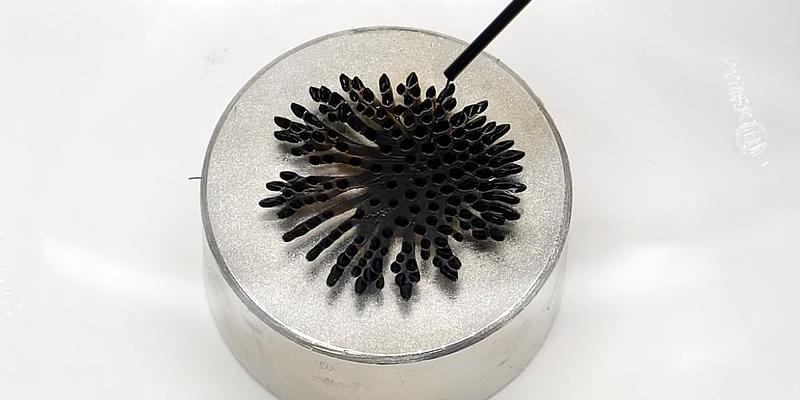[NileRed] admits that while ferrofluid has practical uses, he simply wanted to play with it and didn’t want to pay the high prices he found in Canada. A lot of the instructions he found were not for making a true ferrofluid. He set out to create the real thing, but he wasn’t entirely successful. You can see the results — which aren’t bad at all — in the video below.
We’ve always said you learn more from failure than success. The process of creating ferrofluid involves two key steps: creating coated nanoparticles of magnetite and removing particles that are too large or improperly coated. After the first not entirely satisfactory attempt, [NileRed] tried to purify the material using solvents and magnets to create better-quality particles. Even the “bad” material, though, looked fun to play with along with a powerful magnet.
You’ll see that the material is clearly magnetic, it just doesn’t spike like normal ferrofluid. [NileRed] had commercial ferrofluid for testing and found that if he diluted it enough, it behaved like his homemade fluid. So while not conclusive, it seems like he diluted the batch too much.
We hope to see a better batch from him soon. The base material he used for the first patch was homemade — he covers that in a different video. However, for the second batch, he is going to start with commercial ferric chloride — what we know as PCB etchant.
Even though the experiment was not entirely successful, we enjoyed seeing the process and watching the performance of both the homemade batch and the commercial ferrofluid. He’s getting a lot of advice and speculation in the video comments, and it is very possible a Hackaday reader might be able to help, too.
We’ve seen other reports of unsuccessful ferrofluid production. If you need a practical reason to make or buy some, how about a clock?















More failures, please. Also, I greatly enjoy chemistry hacks. Despite not being successful, this was very informative.
I’ve never tried making ferrofluid, but I’ve made copper nanoparticles. In that process, higher temperatures make the nucleation process go faster, and the precipitated particles are much smaller.
Try the precipitation phase at a higher temperature. If the same rule applies, the nucleation should be faster and you’ll get smaller particles.
What about starting out by separating the magnetic coating from computer tapes? As I understand it, analog tapes use an assortment of particle sizes, but digital tapes don’t, so perhaps the particles are all more the same size.
Use laser printer ink, Luke
Uh, regular toner isn’t magnetic, it’s just plastic and carbon black. Only specialty MICR toner is magnetic, and even it at best will give you results similar to the *failure* described in the video.
Regular HP toner IS magnetic.
https://i.imgur.com/t4IC2J5.jpg
https://youtu.be/UW3HMjFnGL8
This is magnetic toner for MICR reading in bank application, not the regular stuff.
https://www.lasersave.com/index.php?main_page=page&id=17&chapter=0
Maybe ¯\_(ツ)_/¯
It’s noname HP LaserJet 1000 toner bought in offline shop for ~1$ per 100 gramm
Same Samsung ML-1510/1710 toner is magnetic too, but less than HP
I have made nice ferrofluid with HP toner, silicone grease and vodka https://peertube.video/videos/watch/a3bd0c23-58d4-4a55-879d-731bc96d0c8c
Succeeding at making ferrofluid
https://www.youtube.com/watch?v=CWH9C__jn2w
:o)
At best that’s ferropaste.
I love watching videos by NileRed and NurdRage, even if I don’t understand a lot of what is happening, there is plenty I do understand and those parts are made incredibly accessible. The apparatus and how they are used, the problem solving techniques and the general procedures and methodology are all fascinating!
How many miles of magnetic tape do you suppose is needed to strip enough oxide particles from to do anything useful with? An even better question, how many miles ‘Isaac’ are you willing to process? The point here, is that he is trying to synthesize magnetite (Fe3O4) nanoparticles from scratch and properly coat them with an ionic surfactant. Nope ‘Imshara’, toner doesn’t cut it either.
A reason why the toner can’t be used would be nice assuming you know it.
Also Isaac is likely about 1/1000th of a mile.
Wait? What you need is Fe3O4? That is Mars Black pigment. No idea if the particles of art PBk11 are tiny enough, but worth a try to avoid the first steps. Probably, as artist grade pigments tends to be high quality.
It also makes magnetic paint. It will be black, of course, but you can use it as undercoat. Or black resin with magnetic properties when used as filler.
Per this website
https://www.handprint.com/HP/WCL/pigmt3.html#particlesize
typical black iron oxide pigments have a particle size in the 10 micrometer range.
Wikipedia says ferrofluid particle size is 10 nanometers or less, so the artist pigment is not nearly tiny enough.
Does it have to be home-made? I found this (there’s literally a website for everything). At the time I was thinking of the iron powder they sprinkle on breakfast cereal to “fortify” it, but then saw this category. No idea if that’s the right size, but these people seem to have cracked the powdering of iron.
http://www.iron-powders.com/information/Iron_Oxide_Black_Magnetite.asp?count=18